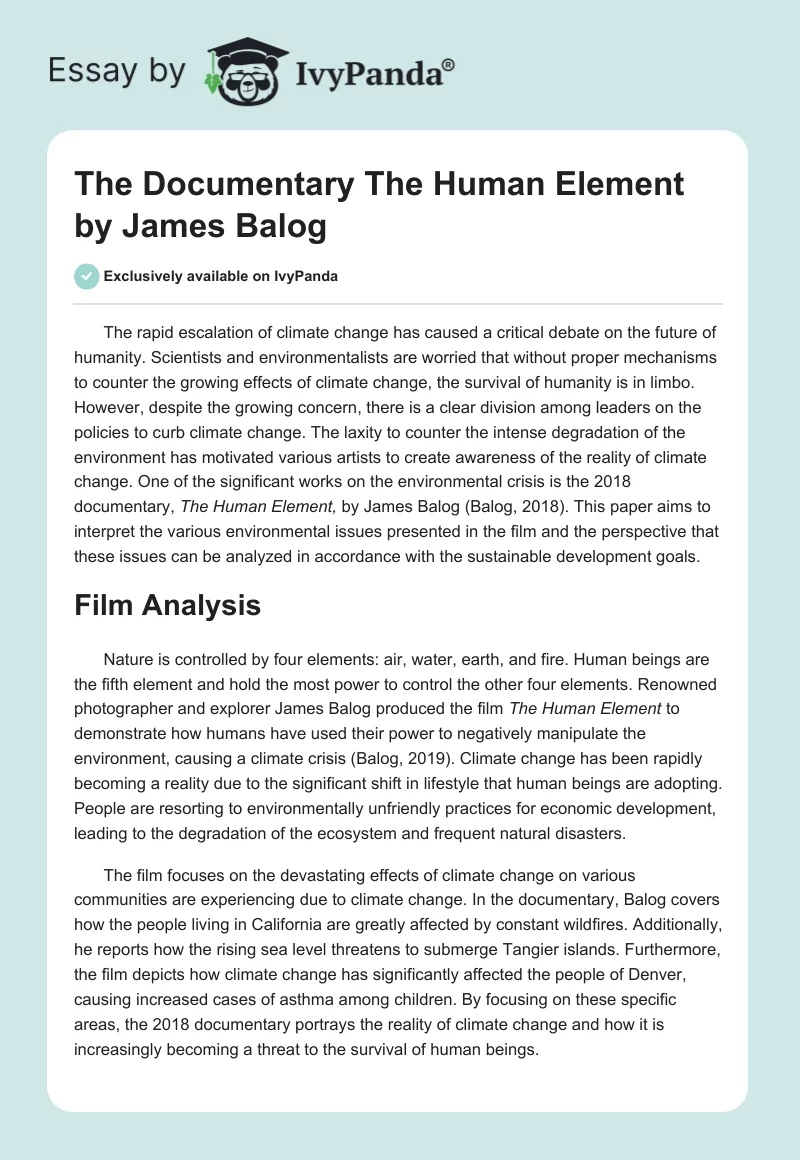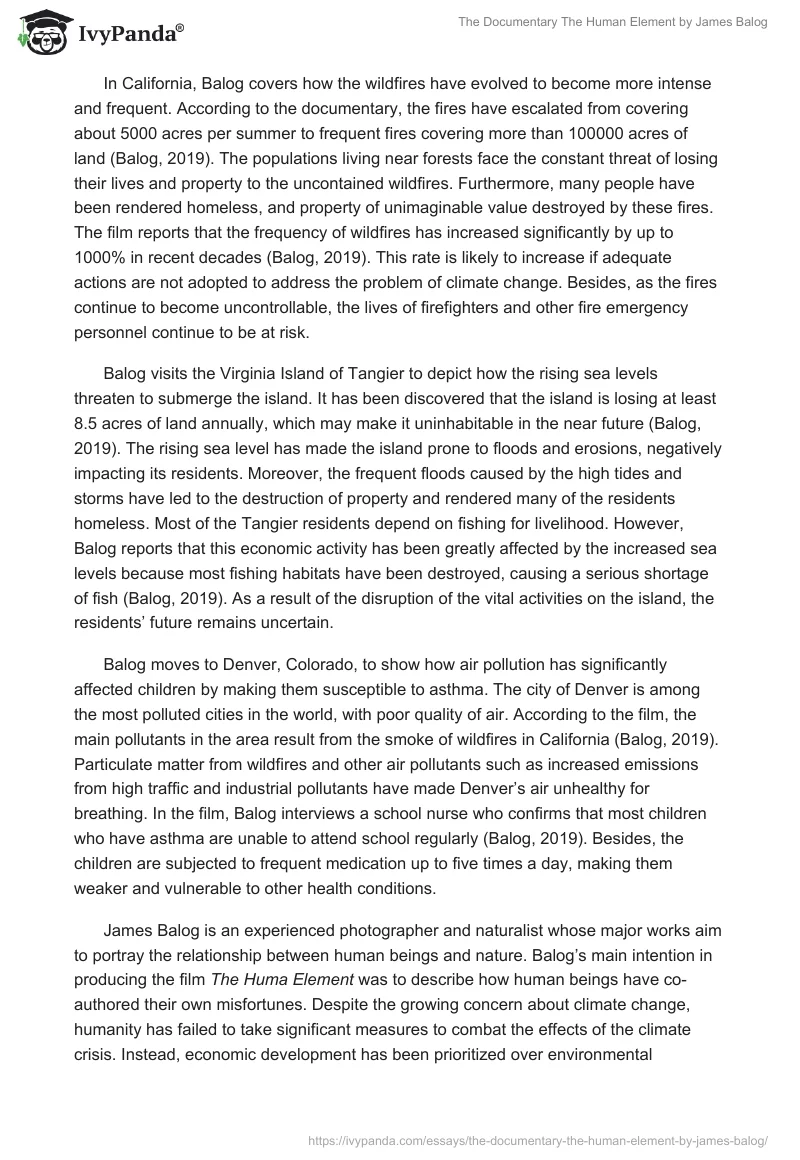The rapid escalation of climate change has caused a critical debate on the future of humanity. Scientists and environmentalists are worried that without proper mechanisms to counter the growing effects of climate change, the survival of humanity is in limbo. However, despite the growing concern, there is a clear division among leaders on the policies to curb climate change. The laxity to counter the intense degradation of the environment has motivated various artists to create awareness of the reality of climate change. One of the significant works on the environmental crisis is the 2018 documentary, The Human Element, by James Balog (Balog, 2018). This paper aims to interpret the various environmental issues presented in the film and the perspective that these issues can be analyzed in accordance with the sustainable development goals.
Film Analysis
Nature is controlled by four elements: air, water, earth, and fire. Human beings are the fifth element and hold the most power to control the other four elements. Renowned photographer and explorer James Balog produced the film The Human Element to demonstrate how humans have used their power to negatively manipulate the environment, causing a climate crisis (Balog, 2019). Climate change has been rapidly becoming a reality due to the significant shift in lifestyle that human beings are adopting. People are resorting to environmentally unfriendly practices for economic development, leading to the degradation of the ecosystem and frequent natural disasters.
The film focuses on the devastating effects of climate change on various communities are experiencing due to climate change. In the documentary, Balog covers how the people living in California are greatly affected by constant wildfires. Additionally, he reports how the rising sea level threatens to submerge Tangier islands. Furthermore, the film depicts how climate change has significantly affected the people of Denver, causing increased cases of asthma among children. By focusing on these specific areas, the 2018 documentary portrays the reality of climate change and how it is increasingly becoming a threat to the survival of human beings.
In California, Balog covers how the wildfires have evolved to become more intense and frequent. According to the documentary, the fires have escalated from covering about 5000 acres per summer to frequent fires covering more than 100000 acres of land (Balog, 2019). The populations living near forests face the constant threat of losing their lives and property to the uncontained wildfires. Furthermore, many people have been rendered homeless, and property of unimaginable value destroyed by these fires. The film reports that the frequency of wildfires has increased significantly by up to 1000% in recent decades (Balog, 2019). This rate is likely to increase if adequate actions are not adopted to address the problem of climate change. Besides, as the fires continue to become uncontrollable, the lives of firefighters and other fire emergency personnel continue to be at risk.
Balog visits the Virginia Island of Tangier to depict how the rising sea levels threaten to submerge the island. It has been discovered that the island is losing at least 8.5 acres of land annually, which may make it uninhabitable in the near future (Balog, 2019). The rising sea level has made the island prone to floods and erosions, negatively impacting its residents. Moreover, the frequent floods caused by the high tides and storms have led to the destruction of property and rendered many of the residents homeless. Most of the Tangier residents depend on fishing for livelihood. However, Balog reports that this economic activity has been greatly affected by the increased sea levels because most fishing habitats have been destroyed, causing a serious shortage of fish (Balog, 2019). As a result of the disruption of the vital activities on the island, the residents’ future remains uncertain.
Balog moves to Denver, Colorado, to show how air pollution has significantly affected children by making them susceptible to asthma. The city of Denver is among the most polluted cities in the world, with poor quality of air. According to the film, the main pollutants in the area result from the smoke of wildfires in California (Balog, 2019). Particulate matter from wildfires and other air pollutants such as increased emissions from high traffic and industrial pollutants have made Denver’s air unhealthy for breathing. In the film, Balog interviews a school nurse who confirms that most children who have asthma are unable to attend school regularly (Balog, 2019). Besides, the children are subjected to frequent medication up to five times a day, making them weaker and vulnerable to other health conditions.
James Balog is an experienced photographer and naturalist whose major works aim to portray the relationship between human beings and nature. Balog’s main intention in producing the film The Huma Element was to describe how human beings have co-authored their own misfortunes. Despite the growing concern about climate change, humanity has failed to take significant measures to combat the effects of the climate crisis. Instead, economic development has been prioritized over environmental conservation. As a result, the environment reacts negatively to the economy by causing immense destruction of property. Balog argues that human beings have shifted from environmentally healthy practices to unfriendly habits that negatively impact the elements of nature (Balog, 2019). For instance, the overreliance on fossil fuels has increased carbon emissions, causing the greenhouse effect, contributing to high heat levels causing frequent wildfires, and melting sea ice and glacier. As a result, this has led to recurrent natural calamities that have caused devastating destructions.
Additionally, Balog uses the film to depict the heroic actions of various people who put their lives on the line while responding to climate disasters. He emphasizes the key roles firefighters play in handling the intense wildfires experienced in California. Despite the fires being largely uncontainable, firefighters have been on the frontline of evacuating victims and property from the intensity of these fires (Balog, 2019). Balog has focused on portraying climate change’s direct effects in his other works, including the Extreme Ice Survey and Chasing Ice (Lam & Tegelberg, 2019). He mainly interacts with the victims of environmental catastrophes and provides actual pictures of the damage caused by climate change. He aims to present the reality of climate change and create awareness of the need to take urgent measures to address this issue and liberate the future from its detrimental impact (Lam & Tegelberg, 2019). By categorizing human beings as an element in nature, Balog concludes the film The Human Element with the hope that humanity will ultimately tilt the balance to level all the aspects of nature and reduce climate change gradually.
Analysis of the Message in the Film
The message presented by James Balog in the film can be analyzed from the perspective that human beings are responsible for the environmental degradation that has triggered the devastating effects of climate change. Economic development policies have greatly undermined the relationship between humanity and the environment. People have manipulated the elements of nature to their advantage without considering the consequences of their actions. As a result, the environment has greatly been degraded, thus unfavorably tilting the balance of nature. Climate change has significantly impacted people’s lives by causing extreme weather conditions such as floods and other disasters such as wildfires and rising ice levels. Additionally, degradation of the environment has made people vulnerable to various health conditions, including respiratory infections such as asthma. Analyzing this film from this perspective makes it easier to track the root cause of the problem and develop efficient mechanisms that can be implemented to counteract the effects posed by climate change.
The specific environmental issue depicted in the film is the effects of climate change. The documentary presents the various ways that climate change continues to threaten the survival of human beings by causing frequent disasters. Understanding the impact of climate change is significant in defining the future of the planet. Having a sense of the future is essential in developing sustainable development goals to create a conducive environment for the prosperity of humanity and its environment. According to the United Nations, the 13th sustainable development goal is Climate Action which involves combating the effects of climate change that have caused increased natural disasters, including earthquakes, flooding, tsunamis, and cyclones (“Sustainable Development Goals”, 2018). These catastrophes continue to claim human life and destroy property of immense value. Therefore, nations need to work collaboratively to implement policies that can address the issue of climate change.
Additionally, the 15th sustainable development goal significantly conforms to the film’s message. This goal aims to restore the quality of the terrestrial ecosystem, including forests, to restore climate balance and reduce climate change (“Sustainable Development Goals”, 2018). Balog, therefore, creates the urgency to implement these sustainable development goals to restore the quality of the environment conducive to the thriving of the planet and its inhabitants. By understanding the key role human beings play in conserving the environment, communities can work together to develop a common mechanism that can be implemented globally to eliminate the practices that cause environmental degradation gradually.
The film effectively conveys the message of the devastating effects of climate change and the critical role that human beings can play in restoring the environment. Balog presents the message in a realistic form by relying on firsthand information from the victims of climate change and scientists. Furthermore, Balog captures the unfolding of natural disasters such as the wildfires, hurricanes, and other events, thus presenting the audience with factual information on the reality of climate change. Conveying the message in its original form plays a vital role in creating awareness and reawakening the urgency to take the necessary measures to confront the danger facing humanity. Additionally, Balog approaches the subject of climate change with a sense of hope that people are a major element in nature and therefore have the power to restore the effects of climate change and redefine the future of the planet. With this sense of responsibility, the United Nations developed sustainable development goals.
In conclusion, the film The Human Element by James Balog addresses the issue of climate change and how human activities have played a significant role in causing the climate crisis. However, Balog presents a message of hope that since human beings are major players in matters of nature, they have the power to restore the environment through proper policies. These policies have been reflected in the UN’s 13th and 15th sustainable development goals to develop a collaborative approach to combating climate change and restoring the ecosystem.
References
Balog, J. (2018). The Human Element [Film]. MediaHome. Web.
Lam, A., & Tegelberg, M. (2019). Witnessing glaciers melt: Climate change and transmedia storytelling. Journal of Science Communication, 18(2), A05.
Sustainable Development Goals. Sdgs.un.org. (2018). Web.


